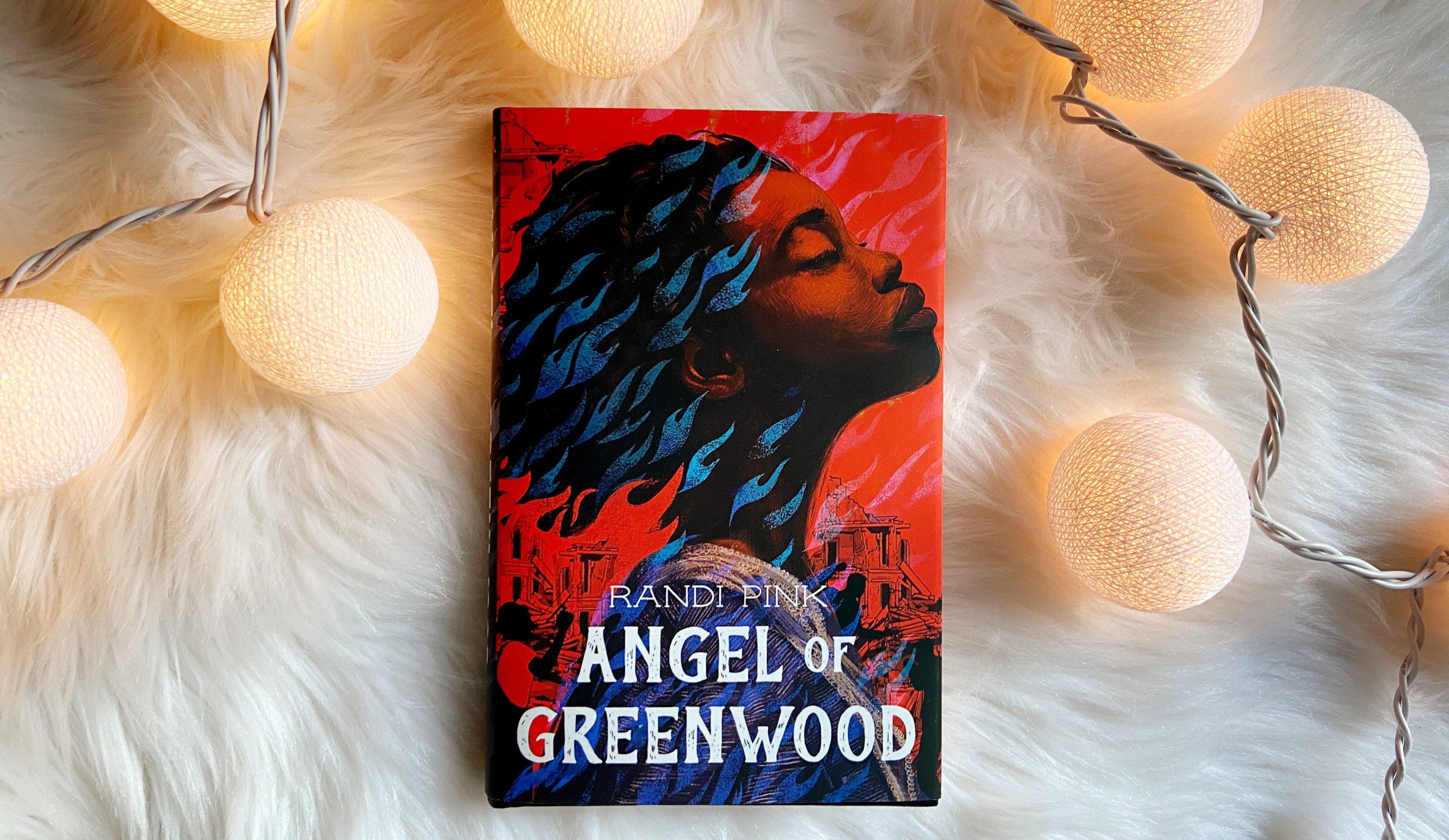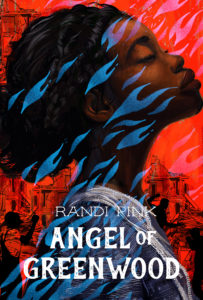Randi Pink on Researching Angel of Greenwood
February 4, 2021 | 10:00 AM
Randi Pink on Researching Angel of Greenwood
By Randi Pink
Researching Angel of Greenwood was a challenge. When I first began, I’d only heard about the Tulsa Race Massacre in passing. The most misleading articles, documents, and books referred to the Massacre as a riot, which, in and of itself, was a blatant misrepresentation of what happened in Tulsa in the summer of 1921. In addition, many facts were intentionally left out of the historical record for nearly a hundred years.
After weeks of what felt like floundering through truth and fiction, I began reading works by Hannibal B. Johnson and Tim Madigan, whose books I found foundational. I lived in Hannibal Johnson’s Oklahoma history until, eventually, reaching out to him personally. He graciously agreed to help with facts and authenticity within Angel of Greenwood and I am extremely grateful for his keen eye and invaluable help. The Tulsa Historical Society also has meticulously archived information on Black Wall Street along with audio of first-hand accounts, photographs, and literature.
One of the most enjoyable parts of my research was exploring Greenwood before the Massacre. My driving force was to ensure that in Angel of Greenwood, Greenwood was more than the Massacre, so I refused to begin with that on page one. Instead, I took the reader through the district in its heyday. Researching Greenwood at its inception sent me on a beautiful journey through post-Reconstruction Black perseverance and excellence. I relished it. I loved it. I revisit that research often.
Another wonderful perk of writing Angel of Greenwood was an excuse to research the overall political climate in the early 1900s. Lively, and sometimes contentious, debates about how to advance the Black community forward were happening everywhere. And reading through archived Black newspapers, autobiographies, and writings of the day was pure joy.
In the novel, I focus much of that political debate around W.E.B. DuBois’ and Booker T. Washington’s philosophies. At the onset, I found it important to understand where in the nation each man came from – regionally and socioeconomically. I was deeply interested in not only how they came to fight for their causes, but how they spent their most impressionable years, especially if born enslaved like Booker T. Washington. In exploring these two men relentlessly for weeks, I found both philosophies to be necessary and independently strong. Two opposite and opposing views, yes, but all needed to break apart hundreds of years of human enslavement.
buy Nootropil generic buybloinfo.com over the counter
After coming to this important conclusion for myself, I channeled those ideals through my protagonists, Isaiah and Angel. And then, along with as much hard-sought research and assistance as possible, focused wholly on bringing them and Greenwood to life for the reader. My hope is that, after finishing the novel, every reader will do their own research and learn more about what happened there, not only on the day of the Massacre, but before.
 Angel of Greenwood by Randi Pink
Randi Pink's The Angel of Greenwood is a historical YA novel that takes place during the Greenwood Massacre of 1921, in an area of Tulsa, OK, known as the "Black Wall Street."
Seventeen-year-old Isaiah Wilson is, on the surface, a town troublemaker, but is hiding that he is an avid reader and secret poet, never leaving home without his journal. A passionate follower of W.E.B. Du Bois, he believes that black people should rise up to claim their place as equals.
buy naprosyn generic buybloinfo.com over the counter
Sixteen-year-old Angel Hill is a loner, mostly disregarded by her peers as a goody-goody. Her father is dying, and her family’s financial situation is in turmoil. Also, as a loyal follower of Booker T. Washington, she believes, through education and tolerance, that black people should rise slowly and without forced conflict.
Though they’ve attended the same schools, Isaiah never noticed Angel as anything but a dorky, Bible-toting church girl. Then their English teacher offers them a job on her mobile library, a three-wheel, two-seater bike. Angel can’t turn down the money and Isaiah is soon eager to be in such close quarters with Angel every afternoon.
buy neurontin generic buybloinfo.com over the counter
But life changes on May 31, 1921 when a vicious white mob storms the community of Greenwood, leaving the town destroyed and thousands of residents displaced. Only then, Isaiah, Angel, and their peers realize who their real enemies are.
Angel of Greenwood by Randi Pink
Randi Pink's The Angel of Greenwood is a historical YA novel that takes place during the Greenwood Massacre of 1921, in an area of Tulsa, OK, known as the "Black Wall Street."
Seventeen-year-old Isaiah Wilson is, on the surface, a town troublemaker, but is hiding that he is an avid reader and secret poet, never leaving home without his journal. A passionate follower of W.E.B. Du Bois, he believes that black people should rise up to claim their place as equals.
buy naprosyn generic buybloinfo.com over the counter
Sixteen-year-old Angel Hill is a loner, mostly disregarded by her peers as a goody-goody. Her father is dying, and her family’s financial situation is in turmoil. Also, as a loyal follower of Booker T. Washington, she believes, through education and tolerance, that black people should rise slowly and without forced conflict.
Though they’ve attended the same schools, Isaiah never noticed Angel as anything but a dorky, Bible-toting church girl. Then their English teacher offers them a job on her mobile library, a three-wheel, two-seater bike. Angel can’t turn down the money and Isaiah is soon eager to be in such close quarters with Angel every afternoon.
buy neurontin generic buybloinfo.com over the counter
But life changes on May 31, 1921 when a vicious white mob storms the community of Greenwood, leaving the town destroyed and thousands of residents displaced. Only then, Isaiah, Angel, and their peers realize who their real enemies are.
 Angel of Greenwood by Randi Pink
Randi Pink's The Angel of Greenwood is a historical YA novel that takes place during the Greenwood Massacre of 1921, in an area of Tulsa, OK, known as the "Black Wall Street."
Seventeen-year-old Isaiah Wilson is, on the surface, a town troublemaker, but is hiding that he is an avid reader and secret poet, never leaving home without his journal. A passionate follower of W.E.B. Du Bois, he believes that black people should rise up to claim their place as equals.
buy naprosyn generic buybloinfo.com over the counter
Sixteen-year-old Angel Hill is a loner, mostly disregarded by her peers as a goody-goody. Her father is dying, and her family’s financial situation is in turmoil. Also, as a loyal follower of Booker T. Washington, she believes, through education and tolerance, that black people should rise slowly and without forced conflict.
Though they’ve attended the same schools, Isaiah never noticed Angel as anything but a dorky, Bible-toting church girl. Then their English teacher offers them a job on her mobile library, a three-wheel, two-seater bike. Angel can’t turn down the money and Isaiah is soon eager to be in such close quarters with Angel every afternoon.
buy neurontin generic buybloinfo.com over the counter
But life changes on May 31, 1921 when a vicious white mob storms the community of Greenwood, leaving the town destroyed and thousands of residents displaced. Only then, Isaiah, Angel, and their peers realize who their real enemies are.
Angel of Greenwood by Randi Pink
Randi Pink's The Angel of Greenwood is a historical YA novel that takes place during the Greenwood Massacre of 1921, in an area of Tulsa, OK, known as the "Black Wall Street."
Seventeen-year-old Isaiah Wilson is, on the surface, a town troublemaker, but is hiding that he is an avid reader and secret poet, never leaving home without his journal. A passionate follower of W.E.B. Du Bois, he believes that black people should rise up to claim their place as equals.
buy naprosyn generic buybloinfo.com over the counter
Sixteen-year-old Angel Hill is a loner, mostly disregarded by her peers as a goody-goody. Her father is dying, and her family’s financial situation is in turmoil. Also, as a loyal follower of Booker T. Washington, she believes, through education and tolerance, that black people should rise slowly and without forced conflict.
Though they’ve attended the same schools, Isaiah never noticed Angel as anything but a dorky, Bible-toting church girl. Then their English teacher offers them a job on her mobile library, a three-wheel, two-seater bike. Angel can’t turn down the money and Isaiah is soon eager to be in such close quarters with Angel every afternoon.
buy neurontin generic buybloinfo.com over the counter
But life changes on May 31, 1921 when a vicious white mob storms the community of Greenwood, leaving the town destroyed and thousands of residents displaced. Only then, Isaiah, Angel, and their peers realize who their real enemies are. 



